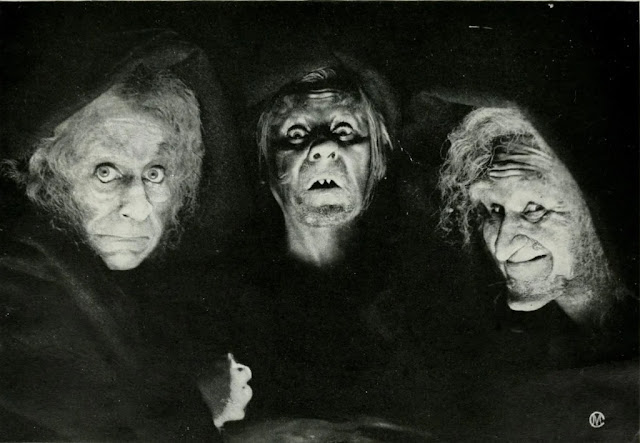If you are reading this you have survived into your second week of Friday Night Frights. Here's the the link to Bev Hankins' contribution: Curses! Spoiled Again! And this, well, weird number is mine:
It has been quite a while since I reviewed something by Charlotte Armstrong here--this review, for example, is over a decade old--but her work is often very good indeed. Anthony Boucher termed her "one of the few authentic spell-catching witches of modern times," so Halloween seems a good time for reviewing a novel by her!
Her "witchy" qualities aside, Armstrong was one of the mid-century American "domestic suspense" writers (Margaret Millar being another) who actually started her crime writing career with detective novels in the classic mold. Her first three mysteries have a series sleuth, a retired American history professor turned detective named MacDougal Duff (aka Mac Duff), who fits neatly into the classic tradition.
In the second novel in the series, The Case of the Weird Sisters (1943), Mac Duff, who pops up briefly in a prologue but doesn't appear to detect, proper, until about 40% of the way through the book, investigates a series of murder attempts in northern Michigan, being on the scene by happenstance in the serendipitous way of amateur detectives.
Let's set Mac Duff aside for a minute and get on to the early narrative. Alice Brennan, personal secretary and fiancee to millionaire Chicago businessman Innes Whitlock, is driving with him to his luxury camp in northern Michigan (the upper peninsula, evidently), when they have car trouble and have to stop for the night at the home of Innes' three half-sisters, the weird sisters of the title--and, boy, are they!
Innes' chauffeur is Fred Bitoski, an appealing fellow who went to the University of Michigan on a football scholarship. Even though Alice has agreed, mercenary fashion, to marry Innes, whom she doesn't love, we can tell right at the start that she has eyes for Fred, shall we say, and Fred for her. Complicating matters, Alice is on the rebound from an unrequited (?) crush on Innes' handsome attorney Art Killeen, who shows up later in the book too. So this isn't just a triangle but a rectangle.
Innes' sisters live in Ogaunee, a dying iron mining town where their father, until his death in a 1925 car accident, was the leading citizen. They still live on the hill in an old mansion as the town's regal gentlewomen, albeit decaying ones, dependent on infusions of cash from their younger half-brother Innes.
Ogaunee pretty obviously is based on the real Michigan town of Negaunee, and the mansion likely is based on the Captain Henry Merry house (see above), which sadly was torn down after many years of decrepitude in 1957. A native Englishman, Merry according to the Mining Journal was the the owner of the Jackson Iron Mine and "Negaunee's most powerful man." Charlotte Armstrong herself was born not too far away at the smaller Michigan town of Vulcan and was the daughter of a mining engineer.
.jpg) |
| Sixties Ace pb reprint In fact the sisters in the book are neither triplets nor hot, nor is one of them green! |
So why are the three sisters weird? Well, partly because they are all deludedly living in their genteel past, very much like characters in a Margery Allingham crime novel. But also because--and I suppose this would be seen as ableist today--they are all physically impaired in some way.
Gertrude, the eldest, is blind, Maud, the middle daughter, deaf, and Isabel, the youngest, has an artificial arm. (She lost the original one in that 1925 car accident with her father.) You might have thought Isabel would be mute--you know, see no evil, hear no evil, speak no evil--but, hey, close enough, right?
Anyway, once Innes is at the house, a series of attempts is made to kill him, though in the event(s), Innes proves more resilient than Rasputin. He's still alive when Mac Duff--Alice and Art are former students of his--appears on the scene to catch the fiend behind the attempts.
Sisters is quite an enjoyable crime novel with very well-realized characters and sparkling writing, but as a formal mystery the book is only middling. There are no great Agatha Christie-like surprises here. Indeed, it is really no surprise that Armstrong would soon turn from detective to crime novels, which play to her great strengths of characterization and suspense.
Interestingly, The Case of the Weird Sisters was filmed in the United Kingdom in 1948, with a script co-written by noted Welsh author Dylan Thomas! The setting quite plausibly is transferred to Wales and it's an entertaining, literate mystery flick of the Old Dark House variety. I will review it here soon.
Admittedly it's far less well known than the two other films from this time based on Armstrong crime novels, The Unsuspected (1947) and Don't Bother to Knock (1952), as is the book itself. But it and the book are worth checking out.


.jpg)
I was inspired by this to check the book out, although unfortunately, Open Road's ebook edition of the book is absolutely littered with typos. Still, it's interesting in spite of that, although so far I feel like the characters have missed several opportunities to realize that their lives are in serious danger and they should abandon ship at any cost.
ReplyDeleteLike I said Innes was lucky he had more lives than Rasputin! Let me know what you think at the end.
Delete